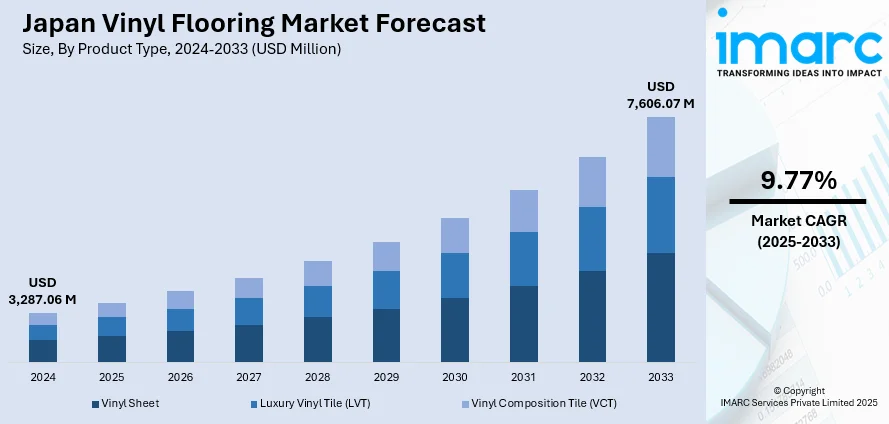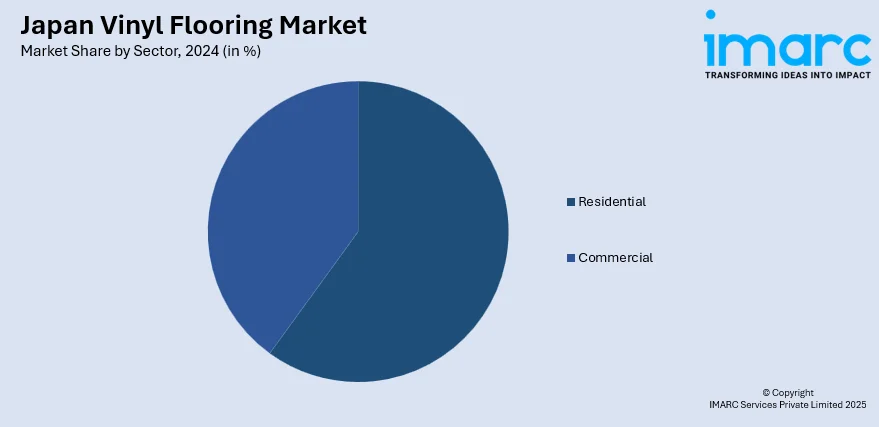
Japan Vinyl Flooring Market Size, Share, Trends and Forecast by Product Type, Sector, and Region, 2025-2033
Japan Vinyl Flooring Market Overview:
The Japan vinyl flooring market size reached USD 3,287.06 Million in 2024. Looking forward, IMARC Group expects the market to reach USD 7,606.07 Million by 2033, exhibiting a growth rate (CAGR) of 9.77% during 2025-2033. The increasing demand for cost-effective and durable flooring, growth in residential renovations, technological advancements in luxury vinyl tile (LVT) and stone plastic composite (SPC) products, and rising preference for eco-friendly materials. Additionally, aging infrastructure and supportive government policies for sustainable and barrier-free housing further propel market expansion.
|
Report Attribute
|
Key Statistics
|
|---|---|
|
Base Year
|
2024
|
|
Forecast Years
|
2025-2033
|
|
Historical Years
|
2019-2024
|
| Market Size in 2024 | USD 3,287.06 Million |
| Market Forecast in 2033 | USD 7,606.07 Million |
| Market Growth Rate 2025-2033 | 9.77% |
Japan Vinyl Flooring Market Trends:
Rising Demand for Eco-Friendly and Recyclable Materials
In Japan’s vinyl flooring market outlook, there's a strong shift toward sustainability driven by environmental awareness and stringent government regulations. Consumers and businesses increasingly prefer vinyl flooring made from recycled or low-volatile organic compounds (VOC) materials. Manufacturers are innovating with bio-based and phthalate-free alternatives to traditional PVC, aligning with Japan’s carbon neutrality goals. Certifications like Eco Mark are becoming a key purchasing criterion. Green building practices in residential and commercial construction further fuel this trend. This eco-conscious momentum is not only shaping product development but also influencing marketing strategies, as brands highlight sustainability credentials to gain a competitive edge. As a result, eco-friendly vinyl options are gaining popularity across homes, offices, and public infrastructure.

Growth of Renovation and Remodeling Segment
Japan’s aging housing stock and demographic shifts are driving strong growth in the renovation and remodeling sector, significantly boosting Japan vinyl flooring market share. Older residential properties are being upgraded to enhance comfort and accessibility, particularly for elderly residents and smaller households. Major renovations defined as projects over 10 square meters rose by 5.2%, reflecting a clear move toward more substantial home improvements. Vinyl flooring, known for its affordability, ease of installation, and low maintenance, is an ideal solution for these upgrades. Government incentives promoting barrier-free and energy-efficient renovations further accelerate this trend. Additionally, a rising interest in rental property enhancements has encouraged landlords to choose stylish and durable vinyl options to attract tenants. With limited land availability and fewer new constructions, the ongoing remodeling boom is expected to sustain vinyl flooring demand in the years ahead.
Technological Advancements in LVT and SPC Flooring
Technological advancements are accelerating the growth of Japan’s vinyl flooring market by enhancing product durability, water resistance, and realism. These innovations appeal to both residential and commercial sectors, offering high-performance flooring solutions that closely mimic the look and feel of natural materials like wood and stone. Digital printing and embossing technologies allow high-definition surface designs that suit Japanese minimalist and modern interiors. Additionally, innovations in click-lock installation systems reduce labor costs and time, making vinyl flooring more accessible for DIY projects and renovations. Soundproofing enhancements and underlayment improvements also align well with Japan’s multi-unit housing market. As performance and aesthetic quality improve, LVT and SPC are replacing traditional flooring like hardwood and laminate at a growing pace.
Japan Vinyl Flooring Market Segmentation:
IMARC Group provides an analysis of the key trends in each segment of the market, along with forecasts at the region level for 2025-2033. Our report has categorized the market based on product type and sector.
Product Type Insights:
- Vinyl Sheet
- Luxury Vinyl Tile (LVT)
- Vinyl Composition Tile (VCT)
The report has provided a detailed breakup and analysis of the market based on the product type. This includes vinyl sheet, luxury vinyl tile (LVT), and vinyl composition tile (VCT).
Sector Insights:

- Residential
- Commercial
A detailed breakup and analysis of the market based on the sector have also been provided in the report. This includes residential and commercial.
Regional Insights:
- Kanto Region
- Kansai/Kinki Region
- Central/ Chubu Region
- Kyushu-Okinawa Region
- Tohoku Region
- Chugoku Region
- Hokkaido Region
- Shikoku Region
The report has also provided a comprehensive analysis of all the major regional markets, which include Kanto, Kansai/Kinki, Central/ Chubu, Kyushu-Okinawa, Tohoku, Chugoku, Hokkaido, and Shikoku Region.
Competitive Landscape:
The market research report has also provided a comprehensive analysis of the competitive landscape. Competitive analysis such as market structure, key player positioning, top winning strategies, competitive dashboard, and company evaluation quadrant has been covered in the report. Also, detailed profiles of all major companies have been provided.
Japan Vinyl Flooring Market News:
- In April 2024, Tarkett launched Collective Pursuit™, its first non-PVC plank and tile flooring collection in North America. Designed to match the performance of luxury vinyl tile, it offers high dimensional stability, impact resistance, and easy maintenance. With nature-inspired designs, including wood and stone visuals, the collection supports sustainability goals for spaces like offices, schools, and hospitals. Collective Pursuit reflects Tarkett’s commitment to innovative, eco-conscious flooring solutions without compromising on performance.
- In January 2024, ITOCHU Corporation, in partnership with CIPS Advance and Lilycolor, launched a flooring material recycling business in Japan with the introduction of DESSO, an eco-friendly product by Tarkett. DESSO features recyclable components and uses ECONYL®, a recycled nylon by Aquafil, in which ITOCHU holds shares. This initiative supports Japan’s move toward a recycling-oriented society, aligning with ITOCHU’s SDGs-driven “Brand-new Deal 2023” strategy for sustainable growth.
Japan Vinyl Flooring Market Report Coverage:
| Report Features | Details |
|---|---|
| Base Year of the Analysis | 2024 |
| Historical Period | 2019-2024 |
| Forecast Period | 2025-2033 |
| Units | Million USD |
| Scope of the Report |
Exploration of Historical Trends and Market Outlook, Industry Catalysts and Challenges, Segment-Wise Historical and Future Market Assessment:
|
| Product Types Covered | Vinyl Sheet, Luxury Vinyl Tile (LVT), Vinyl Composition Tile (VCT) |
| Sectors Covered | Residential, Commercial |
| Regions Covered | Kanto Region, Kansai/Kinki Region, Central/ Chubu Region, Kyushu-Okinawa Region, Tohoku Region, Chugoku Region, Hokkaido Region, Shikoku Region |
| Customization Scope | 10% Free Customization |
| Post-Sale Analyst Support | 10-12 Weeks |
| Delivery Format | PDF and Excel through Email (We can also provide the editable version of the report in PPT/Word format on special request) |
Key Questions Answered in This Report:
- How has the Japan vinyl flooring market performed so far and how will it perform in the coming years?
- What is the breakup of the Japan vinyl flooring market on the basis of product type?
- What is the breakup of the Japan vinyl flooring market on the basis of sector?
- What is the breakup of the Japan vinyl flooring market on the basis of region?
- What are the various stages in the value chain of the Japan vinyl flooring market?
- What are the key driving factors and challenges in the Japan vinyl flooring?
- What is the structure of the Japan vinyl flooring market and who are the key players?
- What is the degree of competition in the Japan vinyl flooring market?
Key Benefits for Stakeholders:
- IMARC’s industry report offers a comprehensive quantitative analysis of various market segments, historical and current market trends, market forecasts, and dynamics of the Japan vinyl flooring market from 2019-2033.
- The research report provides the latest information on the market drivers, challenges, and opportunities in the Japan vinyl flooring market.
- Porter's five forces analysis assist stakeholders in assessing the impact of new entrants, competitive rivalry, supplier power, buyer power, and the threat of substitution. It helps stakeholders to analyze the level of competition within the Japan vinyl flooring industry and its attractiveness.
- Competitive landscape allows stakeholders to understand their competitive environment and provides an insight into the current positions of key players in the market.
Need more help?
- Speak to our experienced analysts for insights on the current market scenarios.
- Include additional segments and countries to customize the report as per your requirement.
- Gain an unparalleled competitive advantage in your domain by understanding how to utilize the report and positively impacting your operations and revenue.
- For further assistance, please connect with our analysts.
 Request Customization
Request Customization
 Speak to an Analyst
Speak to an Analyst
 Request Brochure
Request Brochure
 Inquire Before Buying
Inquire Before Buying




.webp)




.webp)












